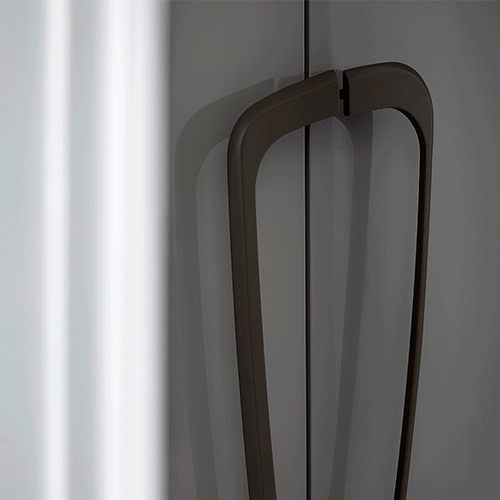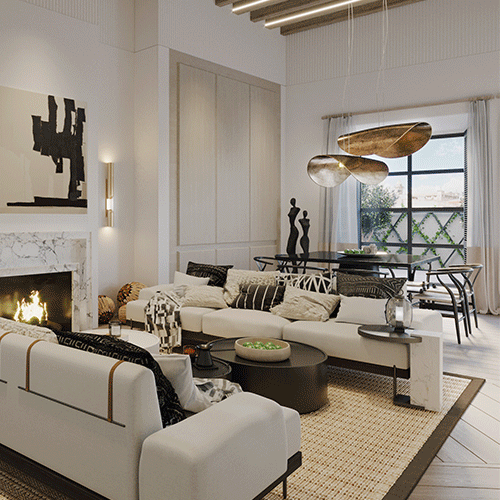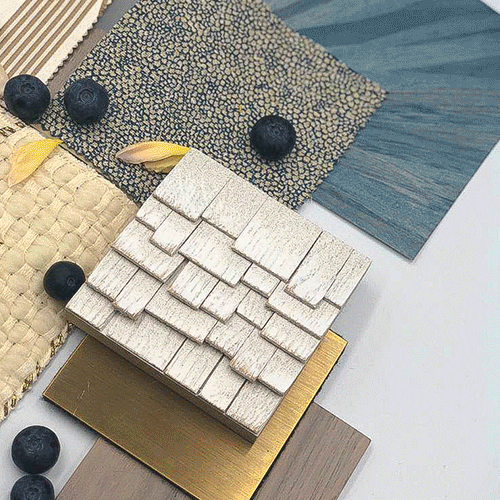In an interview with Portaire, Lena explores the origins of her unique design style, the beginnings of her passion for art, and how you can use art in your next design.
Hi Lena, so happy to be here. How are you?
I’m very well. Thank you for having me.
Awesome, we love chatting to you. So, just for everyone who doesn’t know you: how would you define yourself, what do you do, what do you like?
I am co-Creative Lead for a company called Lawson Robb, and I’d say we’re a multi-disciplinary design studio. We go for anything residential, hospitality or yachts. I think the thing that defines our style, both my personal own and that of my business partner George Wolstenholme’s, is that we have a relaxed, but very curated aesthetic. From my perspective, a lot of that stems from my background. Growing up I moved around a lot; from Asia, the Pacific and Europe… Every place I moved was always very culturally different, and as a family we’d always ended up collecting things for the different countries (especially my mum), and we’d create a home by combining these all together. Then when we’d move we’d take these items with us and decorate our next home with. I’ve always been used to arranging things, curating things, and thus always creating new spaces. I think that this is a very common feature in the spaces that I am drawn to and that I ultimately design. I love contrasting pieces together. I don’t want a completely matchy-matchy environment and I am not interested in completely uniform aesthetics, although I appreciate in certain environments it might be necessary, but it’s not something I really strive for. I really like having pieces speak for themselves, and then somehow, they create a homogenous look once all curated together. I’d say my style is eclectic in terms of mixing things together, but definitely more of a contemporary vibe.
You mentioned that you lived in a lot of places, could you give us a snapshot of what that looked like for you?
The reason why I moved around a lot was because of my dad’s profession running hotels, where he would frequently be relocated. I am half German and half French and was born in Germany but moved straight away to Thailand as a baby. We ended up living there for three years and then moved to Australia, Saudi Arabia, Bali and then back via Germany and Monaco – I’ve now been in the UK for the past 12 years. It’s been a lot of very different places, but it’s been incredibly fun and a unique upbringing. I wouldn’t know it any other way, and it’s definitely shaped the way how I see the world from a design perspective, but also in a way of life really.
You mentioned that your dad works in the hotel industry. Do you think that had a bit to play in how you see interior design?
Yes, because a hotel in itself is an extremely stylised space. All of these hotels were luxury hotels, where design was definitely a big focus point. And so I very quickly learned and understood the effect these places can have on you when you accommodate the space, which I think contributed to my style being of sensory value, but also what pushed me into the industry. I love that when you walk into a space it can make you feel a certain way. And hotels very much do that. They’re meant to be very comforting, a sort of “home away from home”, but at the same time, you do want to experience something you don’t have at home. Maybe it’s a little more tropical, a little more of the destination’s traditional style… It’s a nice escape but also a comfortable escape.
When you were developing your own style, do you think you wanted to separate what works in a hotel and what works in a home, or do you think the two can be blended?
I think the two can be blended. If you view a hotel as a home away from home, you want to make it functional, and to make it comfortable. The difference between a hotel and a private home is that a hotel is catering to a mass audience, the home to a private individual. In a hotel the guest is subjective, and they have generalised habits on how they operate in space. In a private home an individual could have a very particular way of doing things, for example how they like to read; do they like to curl up on a certain chair and if so then that’s something to focus on when designing their spaces. Another example could be that some people may have a big emphasis on bedside tables, and they want to have space for all the books they read, whereas others couldn’t care less and might not even need a bedside table. In a private home you can focus a lot more on the individual, which makes it every time a very different and unique project or space. For a hotel it’s a bigger picture, and you also have to look at the hotel from an operational perspective: housekeeping, room service and all that kind of stuff, from which tips can certainly be applied to a private house. For example, I know that housekeepers have approximately seven minutes to clean a room. If I want to be able to clean this room quickly, I need to make everything accessible, easy to maintain. Why not then use this thought process with your private home and make your personal life easier?
Just to pivot the conversation a bit, I’ve heard that you love art and I’d love to know a bit more about how you got into art and how that journey started for you.
I always knew I wanted to do something creative: Art, or something like that. I definitely went down the route of wanting to do fashion, but I started interning in galleries since I was fifteen years old. I was pretty dead set on that strategy of interning every summer, going off to study art history, and then becoming a gallerist. I loved it, and I learned a lot from it. I’ve always been drawn to Art and always wanted to be around it. To be honest, the way I know if I like something is when I want to touch it… And you can’t always do that! But I realised from working in the industry that it wasn’t quite what I thought it would be. It was very much sales oriented, and I selfishly didn’t like the idea that much of the art that was sold would never be seen again, and that it would be hidden away in a private house. I wanted to work with art in a way where it could be shared, whether it’s in a public space like a hotel or if it is going in a private space, making sure that can become a feature in a home. I loved the idea of helping someone acquire art and becoming really involved in the decision making process, instead of just being a salesperson. I guess it is bit of an innate quality, I’m like a moth drawn to a light. I’ve just always loved art, and knew it was in some shape or form part of my calling.
During that time as an intern in a gallery, you must have seen so many artists and movements. Was there an artist or a style that really captured your attention?
When I was younger, I was obsessed, in love with Jean-Michel Basquiat – so much so that I wrote my thesis on him, I bought every book available and read everything I could about him. I think what drew me to his stuff was aesthetically the mixture of colours, it was very expressive and raw, and for me, like I said earlier, I really want to touch his work. And I think it boils down to the emotion that I really get from the works and how they make me feel. As a whole, I am drawn to more abstract, expressive works. Having lived in Monaco and in the South of France I really loved the local artists; Picasso, Matisse, Yves Klein, Jean Cocteau to name a few… All those artists from that generation were incredible and produced in my mind beautiful works that were expressive yet effortless. Those are the types of pieces I like to consider for our projects.
You mentioned that abstract expressionism is what you push in your projects, because you love the movement, the grit, the colour. How does that process of choosing an artwork look like with your clients?
Choosing an artwork with a client is very much a journey. Sometimes clients will have a clear idea of what they like and might already have a collection which we can build from, but you do meet clients who do not know what they like and need to be educated a little bit. And by no means am I saying I am a pro or fully pledged art historian, but we then sit down and we look at things together and we figure out “Do you like this? Do you like that?”. Many times, clients are not very good at expressing what they like so it’s really about listening to their gut reaction of “Yes, I like this but I don’t know why” and then you pull from that and see what other artists along those lines they could potentially like as well. But then there is of course the question of taste. There’s only so much I can do and obviously, at the end of the day, it is their space, not mine. They need to love it and be comfortable in it. If they want to buy something that’s maybe not 100% my style that’s absolutely OK. I am not here to say “You can’t have that because I don’t like that” – as I said, acquiring and discovering art is a journey and one that I will happily do with the client.
When you get a gut reaction from a client, you start to get a vibe of what they’re into and what they’re not into, what is your journey from there? What do you do after the gut reaction? How do you find the pieces to suit your clients?
It’s a lot of research. I’m really lucky because I had that initial start in the industry and I still have a lot of friends who work in it who I can reach out to, to help me and say “Look, this client really liked this artist, or this piece, can you help me find it/something like that?”. I also try to encourage them to and view art in person. I appreciate it is not always possible, but sometimes a picture does not provide the best representation of a piece and you’d be surprised how much you like it in reality. I also feel that this process shouldn’t be rushed. A piece grows with you over time, and you can end up loving something that you weren’t so sure about at the beginning.
As you explained, art is really central to what you do and how you got into interior design in the first place. How do you centre art in your practice? Is it the first thing that you choose in a room or the last because it’s meant to complement the rest?
I think it’s neither the first or the last thing to look at, it’s very much an along-the-side thing. When my colleague and I design a space we look at the initial floor plans, the layouts and begin to establish key points we need to consider. For example, we could take advantage of this feature wall, identify that this could be a great space for artwork, which then in turn you pre-establish what’s happening a little bit in the spaces. I try to not pick art at the end because it can very much look like an afterthought, and then you get into situations where you’re running out of space and stuck trying to find something that will fit. It’s also nice to consider how the artwork can work with the rest of the scheme and the finishes. Again, I am not into the matchy-matchy idea, but if you can establish a base palette of finishes, you can then find artwork that complements that palette. And it’s a much nicer process than rushing it in the end, and we try to have a discussion with the client early on, establishing “Hey, are you interested in art, and if so, can we get on this straight away”. Even if I know we have time on a project, I want to have that conversation as soon as possible.
As an interior designer who might be starting to centre art in their practice, are there any tips you would suggest?
Yes, have that conversation with a client, but also do a little bit of research, do some reading, visit some galleries. Understand what it is that you are into. For clients and other interior designers, give yourself time and don’t rush it. It should be something you explore, but it’s also as I’ve repeatedly said incurs a gut reaction. Once you have that reaction, go with it.
How do you source art?
It’s a mix of ways. Social media is great at showing you new up-and-coming or local artists. Recently I stumbled onto an artist I am now really interested in procuring for a project and that was just through scrolling on Instagram. I love going to galleries and exhibitions. There are many different platforms you can sign up for that send you invites or keep you posted on what’s happening in the next few weeks. Go out there and see, explore, start meeting people in the industry. You’ll have conversations that will broaden your knowledge. It’s so easy to get stuck on your phone or online and find things through that, but I highly recommend just going out there and going for a walk – you’ll be surprised by what you find.
When you fall in love with a piece or an artist, do you use it as a basis for a project sometimes?
Yes, very much so! It could be a piece I’ve seen or a piece coming from a client, and then you’re like “I’m so in love with this work, let’s make this the hero of this room”. And then you centre everything around it, and it can also help establish how the layout of the room could be, giving it a bit of direction.
Are there any particular things you look at when you’re trying to make a piece of art stand out? Are there any rules you have about it?
No rules really. I think the key thing is lighting, making sure it is well positioned and lit properly. I frequently work with lighting designers, and I have that conversation with them, identifying what needs to be the focus point. They help with the specifying the lighting, which can be pretty complicated, and they can assist with making sure its lit properly without being too bright or too in your face. I’d say that’s the only rule I really follow. Also, just see what happens. You may think you were only going to have one piece in the room and you can end up with two or more. You can evolve, and it doesn’t have to look like it was meant to on day 1. Your project will naturally evolve so have fun with it!
In galleries lighting is super important. At a private house, we also have sunlight and other conservation issues for the art. Are there any considerations you have to make with that in mind?
With very expensive art or pieces you really don’t want to get damaged by, for example, UV light. The sun is really harsh and can do a lot of damage – from bleaching to drying out. You can take it further and fully modify a room by framing art in temperature controlled boxes or make the rooms temperature and humidity controlled. It can get very technical, but don’t stress, that only really happens with very expensive pieces. Bear conservation in mind and if in doubt speak with an art consultant for advice.
Going into colour, is there anything you try to do in a room to make sure the piece stands out? Do you scale back on colours?
A bit of both. I do prefer interiors to be more scaled back, so that the decor and the art can speak louder, but sometimes let’s say you have a piece that has a really strong colour tone of say green, then you could incorporate a bit of that into the accents of the room so that it’s a lot more pleasing on your eye without being an obvious matchy feel. It makes the room feel a little more considered and curated. You can also use elements of an artwork’s colours to influence the rest of the palette.
Are there any projects you could highlight where you were able to develop your vision with art and interiors?
There was a project with a client that had a substantial collection to begin with. The general palette of the house was muted and with the artwork really standing out. We just had to find a few more pieces to fill certain areas of the house, but they were a couple that really understood what they liked, which made it easier for us to help. The client was really open to colour, so we were able to go for it and find more pieces and dress the space with that in mind. Another project that stands to mind was a family house here in London. It was a secondary home so they didn’t wish to spend too much. We actually ended up making bespoke pieces for the space with a local artist, and in particular we made a unique piece that was made with the intention of reflecting some sort of quality of each family member. It became this really personal journey that I was fortunate enough to accompany them on. When it came to the big reveal, their reaction to being able to identify that “this person was this part and that person that part” was so nice. The messages they sent afterwards reminded me of why I do this job. I would love more projects like that.
If you could choose your next big project for a moment, what would you like?
I love to go to exhibitions, and I’d love to have a client who I could do that with. A client who would be open to exploring would be great, someone who had the time to. I appreciate that not everyone has the time, but if I could find that one client had the time to go on those excursions, that would be such fun!
Article Source




